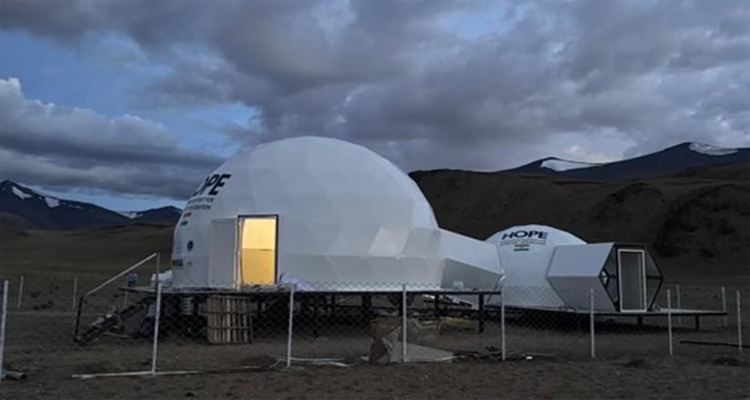
India’s first Mars-analogue base to test life-support systems, astronaut health, and mission protocols in extreme Himalayan conditions
Leh: In a significant step toward India’s future space exploration missions, the Indian Space Research Organisation (ISRO) has launched the Himalayan Outpost for Planetary Exploration (HOPE) in Ladakh’s Tso Kar Valley. Designed to replicate the harsh environmental conditions of Mars, the HOPE station will be used to test technologies and mission strategies for upcoming Moon and Mars expeditions.
The station was formally inaugurated on July 31 by ISRO Chairman Dr. V. Narayanan. It has been developed under the Human Space Flight Centre of ISRO, in collaboration with an industry partner and several premier research institutions in India. The Tso Kar Valley was selected due to its unique landscape and climate, which closely resemble Martian conditions—such as high ultraviolet radiation, extremely low temperatures, low atmospheric pressure, and salty permafrost.
Dr. V. Narayanan, Chairman, ISRO and Secretary, Department of Space, formally inaugurated ISRO’s high-altitude analog mission HOPE on 31st July 2025.
The mission is scheduled to be conducted from 1st to 10th August 2025 at Tso Kar, Ladakh (elevation: 4,530 metres).
Set in one of… pic.twitter.com/zMYeoBdUkT— ISRO (@isro) August 1, 2025
The HOPE station consists of two main modules: an 8-metre-wide crew habitation module and a 5-metre utility module for essential systems and equipment. A 10-day simulated mission began on August 1, during which two crew members will live and work inside the station to test life-support systems, health monitoring equipment, and operational procedures in isolation.
Researchers from institutions like IIT Bombay, IIT Hyderabad, IIST Trivandrum, RGCB Trivandrum, and the Institute of Aerospace Medicine in Bengaluru are conducting experiments during this mission. These include monitoring mental and physical health during isolation, evaluating new medical technologies, simulating surface operations, and collecting microbial samples—activities that are essential for preparing future astronauts for long-duration space travel.
Describing the HOPE mission as “a rehearsal for the future,” ISRO Chairman Dr. Narayanan said the project is aligned with Prime Minister Narendra Modi’s vision to increase private sector involvement in India’s growing space sector.
Meanwhile, in a related scientific breakthrough, researchers from the Birbal Sahni Institute of Palaeosciences (BSIP) have discovered important organic compounds in the geothermal region of Ladakh’s Puga Valley. Their study, recently published in the journal ACS Earth and Space Chemistry, found amino acids, fatty acids, and other life-building molecules embedded in calcium carbonate deposits. These findings could help scientists understand how life might have originated on Earth—and even on Mars—due to the valley’s extreme environment, which mimics early Earth and ancient Martian conditions.
Together, the HOPE mission and the Puga Valley research mark a major milestone for India’s space and astrobiology programs, placing Ladakh at the centre of cutting-edge planetary science.



